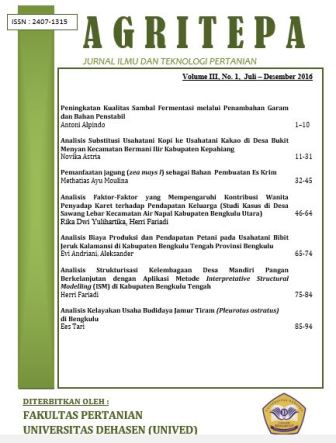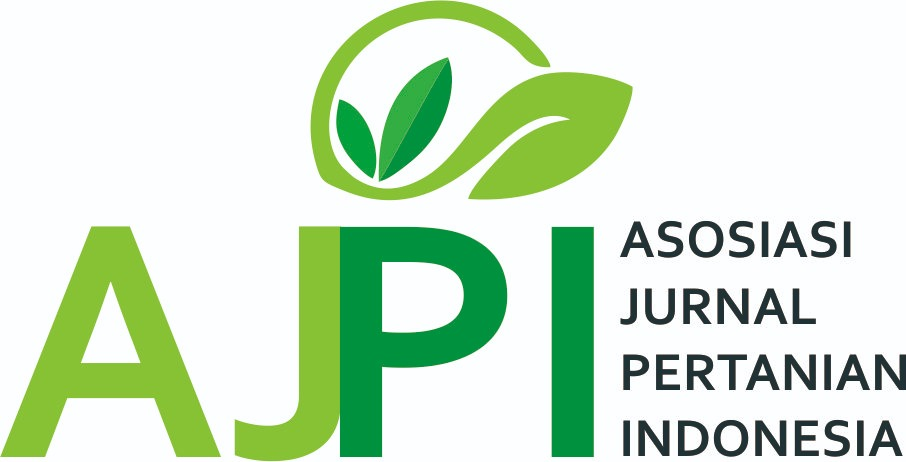Differences In the Antioxidant Activity of Sungkai Leaf Extract Using Methanol And Aquades Solvents
Abstract
The antioxidant activity of natural product extracts is influenced by the type of solvent that plays an active role in binding secondary metabolites such as saponins and flavonoids. Sungkai leaves (Peronema canescens Jack) are plants that have been shown to contain secondary metabolites that have antioxidant activity. The purpose of this study was to determine the differences in the antioxidant activity of Sungkai leaves with different solvents. Sungkai leaves (Peronema canescens Jack) used in this study were obtained in Central Bengkulu Regency, Bengkulu Province. Sungkai leaves are extracted with two types of solvents, namely methanol and distilled water. Furthermore, the analysis of antioxidant activity was carried out using the DPPH method. The results showed that the antioxidant activity of IC50 (inhibitor concentration 50) was 45.709 ppm, which was very strong in methanol extract. Antioxidant activity in distilled water is known to have an IC50 value of 53.979 ppm, which means strong. Furthermore, it can be concluded that the existence of differences in solvents can affect the level of antioxidant activity of Sungkai leaves. Methanol solvent contains stronger antioxidant activity than distilled water.
Downloads
References
Arifin, B., & Ibrahim, S. (2018). Struktur, Bioaktivitas dan Antioksidan Flavonoid. Jurnal Zarah. 6(1): 21–29.
Domithesa, M. C., Putra, I. N. K., & Wiadnyani, A. A. I. S. 2021. Pengaruh Jenis Pelarut Terhadap Aktivitas Antioksidan Ekstrak Daun Kejompot (Crassocephalum crepidioides) Menggunakan Metode Maserasi. Jurnal Ilmu Dan Teknologi Pangan (ITEPA). 10(1): 67.
Fadlilaturrahmah, Khairunnisa, A., MP.Putra, A., & Sinta, I. 2021. Uji Aktivitas Tabir Surya dan Antioksidan Ekstrak Etanol Daun Sungkai (Perenema canescens Jack). Jurnal Ilmiah Ibnu Sina. 6(2): 322–330.
Febrianti, D.R., Ariani, N., Niah, R., & Jannah, R..2018.Aktivitas Antioksidan Ekstrak Metanol Kulit Jeruk Siam Banjar (Citrus reticulata). Jurnal Insan Farmasi Indonesia. 2(1):1-6.
Himawan, H. C., Isa, A. F., & Wiharja, D. S. 2021. Antioxidant Activity Of 70 % Ethanol Extract Combination Of Kemangi Leaf (Ocimum Americanum Linn) and Binahong Leaf (Anredera cordifolia (Ten .) Steenis) Using DPPH
Antioxidant Activity Of 70 % Ethanol Extract Combination Of Kemangi Leaf (Ocimum Amer. Journal of Physics: Conference Series. https://doi.org/10.1088/1742-6596/1764/1/012009
Ibrahim, A., Siswandono, & Ew, B. P. 2021. Cytotoxic Activity of Peronema canescens Jack Leaves on Human Cells : HT-29 and Primary Adenocarcinoma Colon Cancer. Pharmacognosy Journal. 13(6): 1389–1396.
Kasumawati, F., & Hasnah, S. 2022. The Effect of Drying Method on Potential Antioxidants in Ethanol Extract of Sungkai Leaf ( Parenoma Canescens Jack .) Simplicia from Kalimantan Pengaruh Pengeringan Simplisia Terhadap Potensi Antioksidan Ekstrak Etanol Daun Sungkai ( Peronema canescens Jack). Jurnal Ilmiah Berkala: Sains Dan Terapan Kimia. 16(1): 1–8.
Kedare, S. B., & Singh, R. P. . 2011. Genesis and Development of DPPH Method of Antioxidant Assay. Journal Food Science Technology. 48(412–422).
Krisnawan, A. H., Budiono, R., Sari, D. R., & Salim, W. 2017. Potensi Antioksidan Ekstrak Kulit dan Perasan Daging Buah Lemon (Citrus lemon) Lokal dan Impor. Prosiding Seminar Nasional 2017 Fakultas Pertanian UMJ “Pertanian Dan Tanaman Herbal Berkelanjutan Di Indonesia", 30–34.
Kusriani, R. H., Nawawi, A., & Turahman, T. 2015. Uji Aktivitas Antibakteri Ekstrak Dan Fraksi Kulit Batang Dan Daun Sungkai (Peronema Canescens Jack) Terhadap Staphylococcus Aureus Atcc 25923 Dan Escherichia Coli ATCC 25922. Jurnal Farmasi Galenika. 02(01): 8–14.
Latief, M., Sari, P. M., Fatwa, L. T., Tarigan, I. L., & Rupasinghe, H. P. V. 2021. Antidiabetic Activity of Sungkai (Peronema canescens Jack) Leaves Ethanol Extract on the Male Mice Induce Alloxan Monohydrate. Pharmacology and Clinical Pharmacy Research. 6(2): 64–74.
Limbono, S. 2013. Daya antioksidan ekstrak etanol biji kenari (Canarium indicum L.) dengan Metode DPPH (1,1-Diphenyl-2-picrylhydrazyl). Calyptra: Jurnal Ilmiah Mahasiswa Universitas Surabaya. 2(2): 1–9.
Lung, J. K. S., & Destiani, D. P. 2018. Uji Aktivitas Antioksidan Vitamin A, C, E dengan Metode DPPH. Farmaka. 15(1): 53–62.
Maharani, A. I., Riskierdi, F., Febriani, I., & Kurnia, K. A. 2021. Peran Antioksidan Alami Berbahan Dasar Pangan Lokal dalam Mencegah Efek Radikal Bebas. Prosiding SEMNAS BIO 2021 Universitas Negeri Padang, 390–399.
Maigoda, T., Judiono, J., Purkon, D. B., Haerussana, A. N. E. M., & Mulyo, G. P. E. 2022. Evaluation of Peronema canescens Leaves Extract : Fourier Transform Infrared Analysis , Total Phenolic and Flavonoid Content , Antioxidant Capacity , and Radical Scavenger Activity. Macedonian Journal of Medical Sciences. 10: 117–124.
Maulana, A., Putra, P., & Nor, T. 2021. Uji Aktivitas Antioksidan dan Antitirosinase Fraksi n-Butanol Daun Sungkai (Peronema canescens Jack.) Secara Kualitatif Menggunakan Kromatografi Lapis Tipis. Jurnal Pharmascience. 8(2): 90–101.
Miksusanti, Elfita, dan Hotdelina S.2012.Aktivitas Antioksidan dan Sifat Kestabilan Warna Campuran Ekstrak Etil Asestat Kulit Buah Manggis (Garcinia mangostana L.) dan Kayu Secang (Caesalpinia sappan L.). Jurnal Penelitian Sains. 15(2C):60-69.
Molyneux, P.2004.The Use of The Stable Free Radical Diphenylpicrylhydrazyl (DPPH) for Estimating Antioxidant Activity. Songklanakarin J.Sci.Technol.26(2):211-219.
Novita, M., Sulaiman, M. I., & Yura, S. 2016. Pengaruh Jenis Pelarut terhadap Aktivitas Antioksidan dan Kandungan Fenol Beberapa Jenis Bayam dan Sayuran Lain. Jurnal Ilmiah Mahasiswa Pertanian Unsyiah. 1(1): 935–940.
Okfrianti, Y., Irnameria, D., & Bertalina. 2019. Skrining Senyawa Bioaktif Tanaman Sungkai (Peronema canescens Jack). Jurnal Kesehatan, 10(3).
Okfrianti, Y., Irnameria, D., & Bertalina. 2022. Aktivitas Antioksidan Ekstrak Etanol Daun Sungkai (Peronema canescens Jack). Jurnal Kesehatan, 13(2):333-339.
Phaniendra, A., Jestadi, D. B., & Periyasamy, L. 2015. Free Radicals: Properties, Sources, Targets, and Their Implication in Various Diseases. Indian Journal of Clinical Biochemistry. 30(1): 11–26.
Pindan, N. P., Daniel, Saleh, C., & Magdaleni, A. R. 2021. Uji Fitokimia dan Uji Aktivitas Antioksidan Ekstrak Fraksi n-Heksana, Etil Asetat dan Etanol Sisa dari Daun Sungkai (Peronema canescens Jack.) dengan Metode DPPH. Jurnal Atomik. 6(1): 22–27.
Rahman, A., Rengganis, G. P., Prayuni, S., & Novriyanti, I. 2021. Pengaruh Pemberian Infusa Daun Sungkai (Peronema canescens) terhadap Jumlah Leukosit pada Mencit. Journal of Healthcare Technology and Medicine. 7(2): 1–7.
Sari, A. N. 2015. Antioksidan alternatif untuk menangkal bahaya radikal bebas pada kulit. Journal of Islamic Science and Technology. 1(1): 63–68.
Tiwari, P., Kumar, B., Kaur, G., & Kaur, H. 2011. Phytochemical screening and Extraction: A Review. Internationale Pharmaceutica Sciencia. 1(1): 98–106.
Widodo, H., Sismindari, S., Asmara, W., & Rohman, A. 2019. Antioxidant activity , total phenolic and flavonoid contents of selected medicinal plants used for liver diseases and its classification with chemometrics. Journal of Applied Pharmaceutical Science. 9(06): 99–105.
Copyright (c) 2023 Dira Irnameria, Yenni Okfrianti

This work is licensed under a Creative Commons Attribution-ShareAlike 4.0 International License.
Author retains the copyright and grants the journal the right of first publication of the work simultaneously licensed under the Creative Commons Attribution-ShareAlike 4.0 License that allows others to share the work with an acknowledgement of the work's authorship and initial publication in this journal













